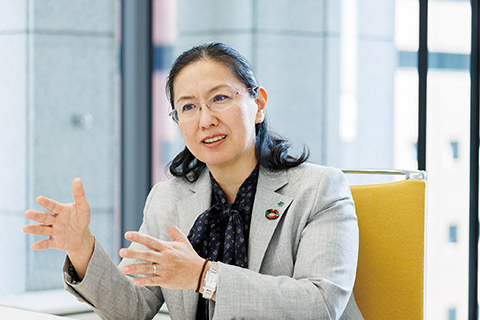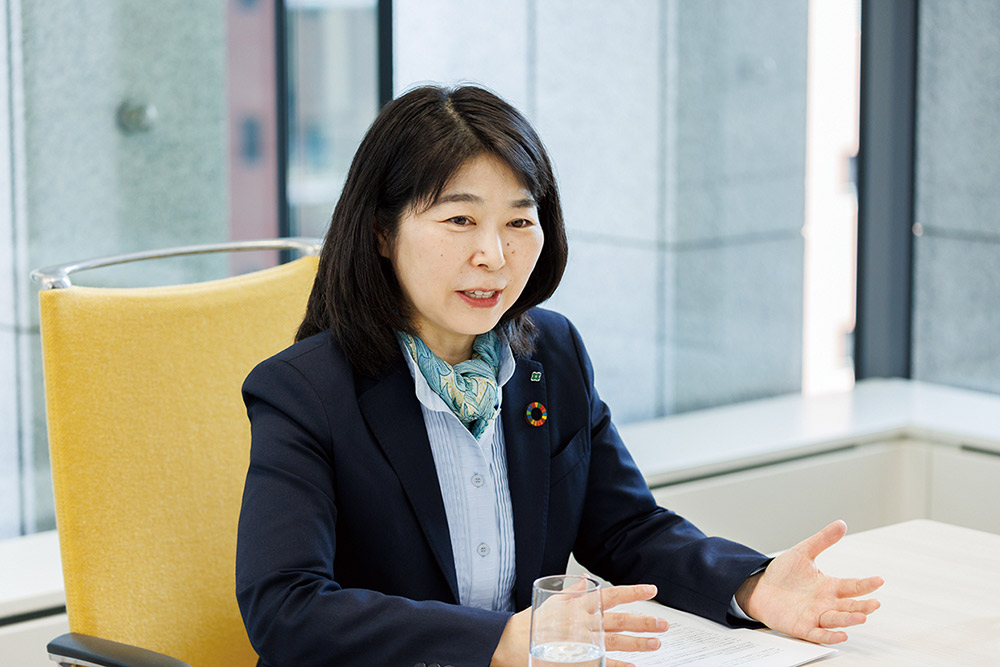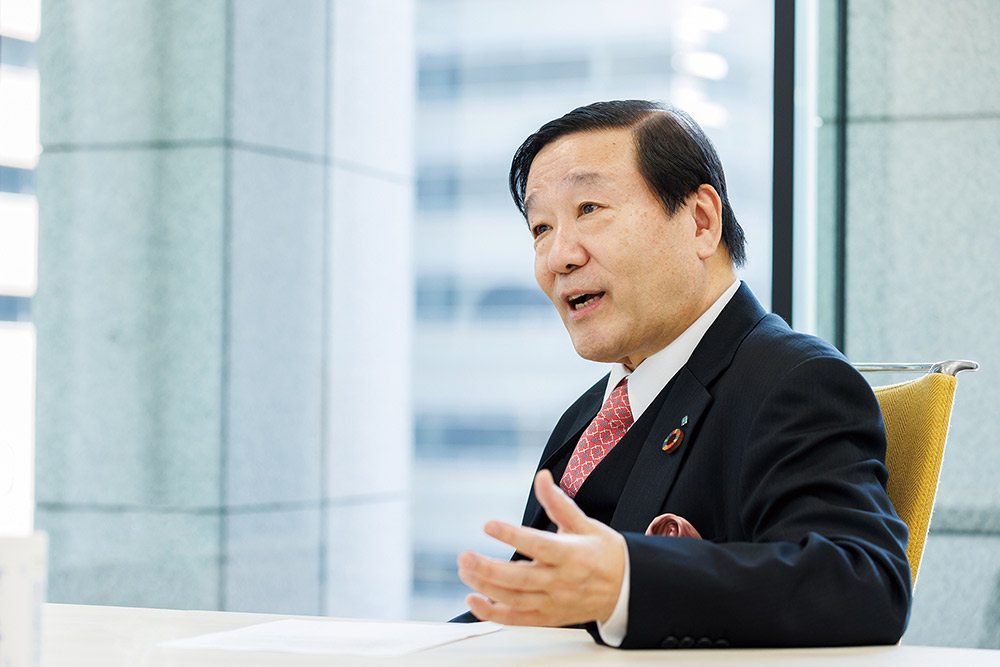Roundtable Discussion of Outside Directors

Strengthening global human resources development and governance toward sustainable growth
How do you evaluate the three years of the previous Medium-term Management Plan Mission TREEING 2030 Phase 1 (2022-2024)? Also, what are your expectations for the new Medium-term Management Plan Mission TREEING 2030 Phase 2, which kicked off in the fiscal year ending December 2025?
Kurihara: In the previous Medium-term Management Plan, Mission TREEING 2030 Phase 1 (the "previous medium-term plan"), Sumitomo Forestry was able to achieve extremely favorable results in terms of performance. This included exceeding the initial plan of 173 billion yen in recurring income for the fiscal year ending December 2024, the final year of the plan, by 25 billion yen. Another notable achievement is that the Company actively invested in M&A, including overseas. By acquiring Metricon, Australia's largest housing company, in November 2024, the Company was catapulted to the top market share of single-family homes starts in Australia. In the United States, the Company made progress in entering the FITP business and in the formation and management of forestry funds. I believe that the previous medium-term plan was a time when the Group expanded its business upstream, midstream, and downstream. The new Medium-term Management Plan, Mission TREEING 2030 Phase 2 (the "new medium-term plan") will see the Group aim to further accelerate growth overseas and to achieve high added value domestically. To achieve these goals, we have set three key measures. The first is human resources development, particularly the development of local talent and global management talent. The second is to promote our environmental contributions, including not only the effect of reducing CO2 emissions but also the conservation of natural ecosystems, through our unique Wood Cycle value chain toward the realization of a sustainable society. The Group will also visualize the financial impact (earning power) that leads to the creation of economic added value in its business and communicate it to stakeholders. The third is to strengthen cross-sectional corporate functions through the newly established Corporate Division.*1
*1 The Corporate Division was newly established on January 1, 2025, incorporating all organizations within the head office, except for the Customer Service Department and the New Business Development Department. This aims to strengthen collaboration among Head Office organizations, enhance personnel development and support functions for business divisions, and promote efforts to address various management challenges such as human resources development and DEI.
Toyoda: I became an outside director in 2023, during the second year of the previous medium-term plan. As Ms. Kurihara noted, the period of the previous medium-term plan was one in which the Group's overseas business expanded significantly through investment and acquisitions. In particular, the forestry funds, one of the businesses launched during the previous medium-term plan period, are rigidly connected to the Company's original business. I recognize it as a business with multiple significance in that it contributes to environmental conservation and the future of humanity, and look forward to its future growth. Moreover, in the process of considering the new medium-term plan, we, the outside directors, were able to have in-depth discussions that went into even the smallest details at meetings of officers*2 and Board of Directors meetings, so I also highly value this process.
*2 Meetings where management holds lively discussions mainly about business strategies. Participants include all directors, as well as Audit & Supervisory Board members and the general managers of each business division.
Iwamoto: I became an outside director in 2024, the third year of the previous medium-term plan. As both of you have just talked about, the Group achieved remarkable growth over the three years of the previous medium-term plan. However, after observing for a year as an outside director, there are some concerns I have, such as whether the people within the Company are keeping up with this rapid growth. For example, although Sumitomo Forestry has a strong brand power in Japan for custom-built wooden houses, currently more than 70% of its profits are generated from its overseas housing business. I feel that this reality has not been communicated sufficiently to stakeholders. In addition, the new medium-term plan should not only aim to achieve numerical targets, but also widely promote Sumitomo Forestry's culture and the value it creates toward the Green Transformation (GX).*3
*3 A transformation of the entire socio-economic system (as defined by the Ministry of Economy, Trade and Industry) that views initiatives to achieve a decarbonized society as an opportunity for economic growth and aims to reduce emissions and improve industrial competitiveness.
What are the challenges in achieving the new medium-term plan?
Iwamoto: Currently, overseas employees account for nearly 50% of the Company's total workforce, so in addition to maintaining its unifying power, the Group needs to further strengthen its governance system globally. However, it is assumed that 20 years are necessary to develop human resources who can compete globally, so digital technologies are an effective tool to make up for the shortage of human resources. On the other hand, the introduction and use of digital technologies require a considerable investment. As such, this should be addressed by setting priorities.
Kurihara: The establishment of the Corporate Division is a major point in the new medium-term plan. I think it is important that this organizational reform strengthen corporate functions, such as human resources development, globalization, workplace improvements, safety management, and compliance. I hope that this leads to further advancements in management resources and risk management.
How do you assess the effectiveness of the Company's Board of Directors?
Iwamoto: The Company has an Audit & Supervisory Board, and I have the impression that the functions of the Board of Directors are management-oriented. In other words, the Board of Directors functions as the final decision-making body, and when implementing a policy, approval is obtained at the Board of Directors meetings. This is the so-called traditional approach of a Board of Directors. However, for example, companies with a governance structure with a Nominating Committee, etc., now have a Board of Directors that is almost entirely focused on monitoring. Of course, even under the current system, advice on management and execution is being provided properly. However, if it moves to a monitoring-type system, the themes that the Company discusses at Board of Directors meetings will also change. Personally, I think that the Board of Directors should spend more time discussing strategies and the allocation of management resources.
Toyoda: Companies with an Audit & Supervisory Board, Audit & Supervisory Committee, or Nominating Committee, etc. have different legal structures in terms of the extent to which business execution matters can be delegated to individual directors and executive officers. Companies with an Audit & Supervisory Board are said to have a management-type structure, and there is a legal requirement that certain important matters must be resolved by the Board of Directors. Sumitomo Forestry is currently operating within that framework. However, even with the current structure of a company with an Audit & Supervisory Board, it is more than possible to balance management and monitoring. The Company has already established a voluntary Nomination and Remuneration Advisory Committee. I think that the nature of governance will change significantly depending on how it is operated. On the other hand, currently, a lot of time is spent on individual matters. As Mr. Iwamoto said, it would be good to secure a little more time to discuss strategy at Board of Directors meetings. For example, because materials are shared in advance, the time spent explaining individual matters at the Board of Directors meeting can be shortened to a certain extent, and that time can be spent on strategy discussions.
Kurihara: I also feel that at Sumitomo Forestry, individual issues are discussed at Board of Directors meetings quite often. Although the criteria for issues to be submitted to the board are reviewed every year, I believe that efficient discussions can be achieved by thoroughly examining the strategies and risks to be discussed and better organizing the agenda. Meanwhile, the Board of Directors is made up of directors and Audit & Supervisory Board members with diverse backgrounds. An environment has also been created in which opinions can be freely expressed. All members proactively voice their sometimes harsh opinions, not just on the pros and cons of issues, but also from the perspective of what Sumitomo Forestry should be addressing. For these reasons, I highly regard the Board of Directors as functioning effectively.
Iwamoto: Monitoring is the duty of the Board of Directors, whether it is a company with a Nomination Committee, etc. or with an Audit and Supervisory Board. As Ms. Toyoda said, there should be room for improvement if we change the allocation of time or pursue other creative approaches. Perhaps because Sumitomo Forestry is a company with a long history, it tends to stick to traditional approaches. However, defining the themes to be discussed at Board of Directors meetings is an especially crucial point in increasing board effectiveness, so I would like to continue to consider various reforms through discussions.
What kind of discussions are held at Board of Directors meetings regarding capital policy and shareholder returns?
Toyoda: The Group has been proactive in investing to date, which has proven to be successful. I believe there will be many investment opportunities in the future, particularly overseas, that will allow the Group to leverage its strengths. Therefore, it is appropriate to sustain the capital policy of allocating funds with a focus on profit reinvestment rather than share buybacks. I believe that these proactive investments are also being evaluated as part of the uniqueness and future potential of the Company's businesses, which are centered on the Wood Cycle. It is necessary for us to continue to communicate our capital policy going forward.
Iwamoto: Regarding indicators such as ROE and PER, the Company should discuss these indicators only after all members of the management team are truly convinced of their necessity. I also believe that there is currently no need for the Company to engage in share buybacks, and that in order to increase corporate value, it is a good policy to focus on reinvesting profits.
What kind of discussions, including at the Nomination and Remuneration Advisory Committee, are taking place regarding succession plans for management?
Kurihara: As for the management level, Sumitomo Forestry selects and develops human resources for each hierarchical level, but the lack of diversity in terms of gender and globalization has been discussed at both meetings of the Board of Directors and the Nomination and Remuneration Advisory Committee, and there is room for improvement. Each business division has a list of candidates for the next generation of management. I have said that it would be good to have a system in place to set up areas where the management team would like to strategically develop the type of human resources they need and develop them in a systematic manner. Although the skills currently possessed by directors have been disclosed, the lack of a clear definition of the required qualities and selection criteria is an issue. President Mitsuyoshi has demonstrated excellent management skills for business growth, including promoting reforms to close the gap between issues faced by the front lines and the head office. In this respect, I fully appreciate the selection of management, but would like to clarify the criteria and check the progress in order to develop and secure the next generation of talent.
Toyoda: Human resources are becoming more mobile, so it is necessary to update and organize them from time to time, such as adding mid-career hires to the management talent pool. In terms of the management selection process, the role of nomination committees and other bodies varies from company to company. It is certain, though, that the trend is to move away from closed-door selection to a process that involves the judgment of many people. In light of this trend, I think the Company should also clarify the selection criteria for directors and the definition of the qualities required of managers, and disclose them as well.




